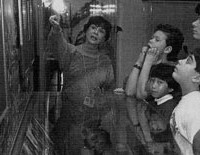Volume 38 / Number 1
1996
On The Cover: The current textile inventory of Mrs. Hoan, a weaver in northern Vietnam. Five rolls of white cloth lay at the bottom of her basket. She said this cloth was used for burial shrouds. Photo by H. Leedom Lefferts, Jr.
Vol. 38 / No. 1
By: Richard L. Zettler
Tell es-Sweyhat, 1989-1995: A City in Northern Mesopotamia in the 3rd Millennium B.C.
Tell es-Sweyhat is a large 3rd millennium site on the Euphrates River in northern Syria. Excavations undertaken in the mid-1970s […]
View ArticleVol. 38 / No. 1
By: Jeremy A. Sabloff
Settlement Patterns and Community Organization in the Maya Lowlands
Since the last century the principal emphasis of Maya studies has been on the ancient Maya elite. This fact is […]
View ArticleVol. 38 / No. 1
By: Michael D. Danti
The Tell es-Sweyhat Regional Archaeological Project
The Tell es-Sweyhat project’s research design extends beyond the site-specific level of analysis to cover broader issues, regional and interregional […]
View ArticleVol. 38 / No. 1
By: H. Leedom Lefferts, Jr.
The Ritual Importance of the Mundane:: White Cloth Among the Tai of Southeast Asia
Often, when we consider that something has ritual importance, we imagine it as exotic, strange, and, possibly, wondrously beautiful. We […]
View Article
Vol. 38 / No. 1
By: Stephen M. Epstein
Musings and Visions from the Museum – Spring 1996
Perhaps the most self-evident aspect of the University of Pennsylvania Museum’s mission is stewardship of the artifacts in our care. […]
View ArticleVol. 38 / No. 1
By: Jeremiah Dandoy
Astragali, the Ubiquitous Gaming Pieces: Reviews and Reports
The astragalus, or talus, is a uniquely shaped, compact bone (Fig. 2) found in virtually every mammal including humans. It […]
View ArticleVol. 38 / No. 1
By: Peter Peregrine
Geomagnetic Mapping at Tell es-Sweyhat
The premise of the archaeological use of geomagnetic is that archaeological deposits can be recognized as disruptions of the otherwise […]
View ArticleVol. 38 / No. 1
By: Naomi F. Miller and Jill Anne Weber
Botanical and Faunal Remains from Tell es-Sweyhat
Botanical Remains Charred plant remains from ancient sites open a window onto many aspects of ancient Landscape and economy. In […]
View Article